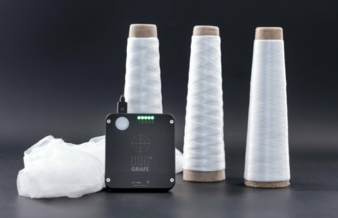21/09/2020 — auf Deutsch lesen
Grafe product protection for fibre applications
In order to guarantee product protection and prevent brand piracy, Grafe has developed a simple yet elegant solution. Special markers are the basis.
Tiny quantities of these custom designed, highly complex pigments with special physical properties are inserted within the plastic matrix. Products containing these pigments can be authenticated using detectors calibrated for and able to read out these special markers. At the same time, there are normally no changes in properties.
Dr. Frank Claußen, team leader of the Analytics Department:
"The markers can only be chemically detected by very complex analytical methods. And the property profiles with the specific structure and composition necessary for detection can only be produced by the respective manufacturers. Since no additional processing steps are required, the markers can either be part of a standard masterbatch or simply added as special marker masterbatches".
Simon Elias, Team Leader Development Fiber and Technical Goods:
"With few exceptions, the markers can be combined with all other common colorants, additives and fillers depending on customer requirements. The special pigment is not damaged by the usual processing methods for thermoplastics, including the spinning process, and is resistant to solvents and washing solutions."
Combinations with other authentication features or special solutions that also provide quantifiable information are also possible. By using the special markers, products can be authenticated reliably without a complex analysis.
The marker masterbatches offered by Grafe can be incorporated into all polymers e.g. in PA, PET or PP and are also ideally suited for fiber applications.
Moreover, these "marked" fibres can also be used in combination with other non-treated fibres.
Independent of their chemical nature, they can be used to form textile fabrics, ropes or similar products.
Product and brand piracy has become a huge problem in the textile industry in recent years. While the counterfeiting of a branded T-shirt as a holiday souvenir has become commonplace, the failure of a technical component or protective device, such as a safety belt, can have serious consequences, not only in financial terms. As the shape and colour of the article is no longer an obstacle for a skilled product pirate, a chemical analysis of the components is usually the only way to provide information about the original manufacturer.
Using modern analytical methods such as thermogravimetry, DSC, infrared spectroscopy, mass spectroscopy, AAS or ICP, X-ray fluorescence spectroscopy, HPLC, etc., trained specialists can analyse the type of polymer materials, as well as the dyes and additives used. A wide range of mechanical or physical testing methods, as well as application-specific tests allow the quality of the end products to be checked. This allows imitation products to be identified in many cases.
In practice, however, these methods require an inordinate expenditure of time and effort and almost identical imitation products are nevertheless very difficult to distinguish from the originals. It is thus a question of whether the cost and effort are worth the investment when detecting counterfeits. This is where Grafe comes in with its smart and highly effective method.




